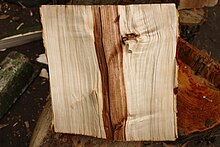Radical 90
| 爿 丬 | ||
|---|---|---|
| 89 ⽘ ◄ | 90 | ► ⽚ 91 |
| Pinyin : | qiáng or pian (= split wood) |
|
| Zhuyin : | ㄑ ㄧ ㄤ or ㄆ ㄧ ㄢ | |
| Hiragana : | し ょ う へ ん shôhen | |
| Kanji : | 爿 偏 shôhen | |
| Hangul : | 조각 널 | |
| Sinocorean : | 장 | |
| Codepoint : | U + 723F 4E2C |
|
| Stroke sequence : |
|
|
Radical 90 , meaning “split wood ”, is one of 34 of the 214 traditional radicals in Chinese writing that are written with four strokes.
With 8 character combinations in Mathews' Chinese-English Dictionary, there are very few characters that can be found under this radical in the lexicon.
The radical "split wood" takes only in the traditional characters - list of traditional radicals consisting of 214 radicals 90th position. It can be found in a completely different place in modern abbreviation dictionaries. In the New Chinese-German Dictionary from the People's Republic of China, for example, it is in 42nd position as an abbreviation.
The seal form shows a vertically split tree 木 (mu), from which 爿 (left) and 片 (right) result. As a component in the compound symbol, 爿 (qiang) often takes the shortened form 丬 so that 將 (jiang = to become) becomes 将 (jiang) or 壯 (zhuang = strong) becomes 壮 (zhuang). However, there are also signs where there is no shortening of the component, for example in 戕 (= murder), 臧 (zang = good), 奘 (= large in the sense of significant person, such as in the name of the famous Tang monk 玄奘Xuan Zang , who brought the Buddhist scriptures from India to China through his journey to the West (Xiyouji). In all of these signs, 爿 (jiang) acts as a sound carrier.
Not appearing as a single symbol, the original form shows an erected bed with the feet pointing to the left. From the inventor of the radical system, Xu Shen (许慎), 丬 (爿 qiang) was not yet listed as a radical, although it was already used as a component in the Warring States' times . 丬 (爿) has been used as a radical since the Ming Dynasty . Some dictionaries list the component as 丬, some as 爿.
Write variant of the radical: Abbreviation (PRC)丬, actually a combination of signs of the radical 2 (丨) with two strokes.
Character combinations ruled by radical 90
| Strokes | character |
|---|---|
| + 0 | 爿 丬
|
| + 4 | 牀
|
| + 5 | 牁
|
| + 6 | 牂
|
| + 9 | 牃
|
| +10 | 牄
|
| +11 | 牅
|
| +13 | 牆 |
In the Unicode block Kangxi radicals , radical 90 is coded under the code point number 12.121 (U + 2F59).
literature
- Edoardo Fazzioli : Painted Words. 214 Chinese characters - from picture to concept . Marixverlag, Wiesbaden 2004, ISBN 3-937715-34-7 , p. 139 .
- For detailed references, see List of Traditional Radicals: Literature
Web links
- Xiù cai.oai.de (PDF; 1.72 MB) Explanation of Radikal 90 on pages 20 and 87

